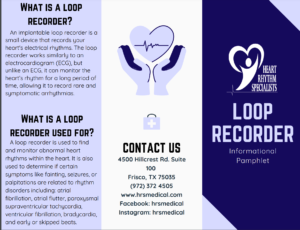What is a Loop Recorder?
An implantable loop recorder is a small device that records your heart’s electrical rhythms. The loop recorder works similarly to an electrocardiogram (ECG), but unlike an ECG, it can monitor the heart’s rhythm for a long period of time, allowing it to record rare and symptomatic arrhythmias.
What is a Loop Recorder used for?
A loop recorder is used to find and monitor abnormal heart rhythms within the heart. It is also used to determine if certain symptoms like fainting, seizures, or palpitations are related to rhythm disorders including: atrial fibrillation, atrial flutter, paroxysmal supraventricular tachycardia, ventricular fibrillation, bradycardia, and early or skipped beats.
What happens in a Loop Recorder?
- Before the procedure begins, local anesthesia, such as lidocaine, will be given in the area where the implant will be placed. A small, 0.5-inch incision will be made in the upper chest area and a small pocket will be created underneath the skin. Dr. Yoo will guide the loop recorder into the pocket and then the incision will be sutured and glued.
- The loop recorder can record for 2-3 years. This procedure takes 20-30 minutes and takes place in the hospital.
Pre-Procedure Instructions
- Do not eat for 6-8 hours, or the night before the procedure.
- Notify Dr. Yoo about any medications you are taking and follow instructions on whether to continue or stop them before the procedure.
- Talk to Dr. Yoo about when to stop bloodthinners.
Post-Procedure Instructions
- Normal activities can be resumed immediately after procedure.
- Follow instructions on how to use the activator and send remote transmissions.
- After the procedure, be mindful of the suture and glue until the entire area is healed.
- Although you may drive after the procedure, it is suggested that someone else drive you home.
Additional Resources:
- Refer to the surgical booklet provided if you are a current patient.
- You may refer to the websites linked below.
